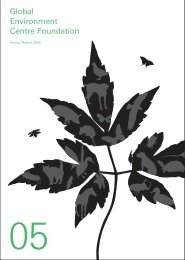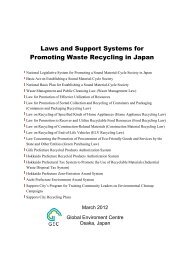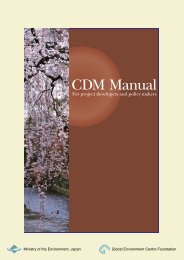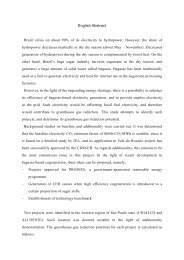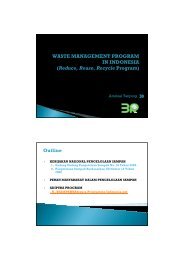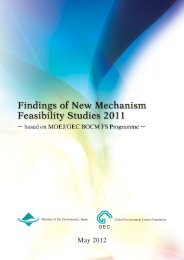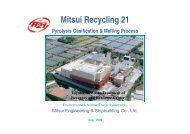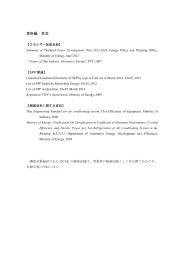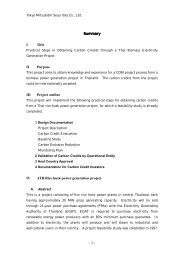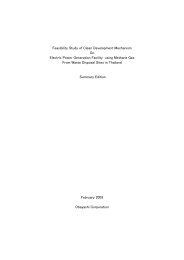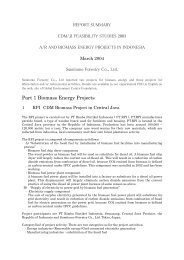PDF File - GEC
PDF File - GEC
PDF File - GEC
Create successful ePaper yourself
Turn your PDF publications into a flip-book with our unique Google optimized e-Paper software.
shifting, effects on all carbon pools shall be considered;<br />
(b) In the case of fuel wood collection or similar activities outside the project boundary, only the<br />
gathered volume of wood that is non-renewable shall be considered as an emission by sources<br />
if forests are not significantly degraded due to this activity. The equation (Eq. 3.2.8) for fuel<br />
wood gathering as outlined in IPCC Good Practice Guidance for Land Use, Land-Use Change<br />
and Forestry (IPCC-GPG) (2003) could be applied in combination with household surveys<br />
or Participatory Rural Appraisal (PRA). In the case that forests are significantly degraded,<br />
accounting rule 1 applies. “Not significantly degraded” means that the extracted volume<br />
results in emissions which are between 2% and 5 % of actual GHG removals. If the extracted<br />
wood volume results in emissions which are below 2% of the actual GHG removals, this type<br />
of leakage can be ignored.<br />
The EB approved the tool for testing the significance of GHG emissions in A/R CDM project activities<br />
[EB31, Annex 16]. The tool assists project participants to transparently demonstrate, which GHG<br />
emission sources, possible decreases in carbon pools and leakage emissions are insignificant for<br />
a particular CDM A/R project activity and therefore can be neglected. Or when required by the<br />
applicability conditions of AMs, whether increases in GHG emissions for a particular CDM A/R project<br />
activity are significant. The EB also clarified that this tool supersedes the guidance provided by the<br />
EB in the EB 22 Annex 15 para. 3(b), concerning ignoring leakage emissions from extraction of nonrenewable<br />
fuel wood. [EB31, para. 47]<br />
(5) Section E. Monitoring plan<br />
In the section E of monitoring, project participants describe, according to the monitoring<br />
methodology they selected, methods to collect and archive data necessary for estimating GHG<br />
removals. The results of monitoring will be used to calculate the difference between GHG removals in<br />
baseline scenario and in project scenario. The monitoring plan needs to provide detailed information<br />
related to the collection and archiving of all relevant data needed to estimate or measure verifiable<br />
changes in carbon stocks in the carbon pools and the emissions of GHG occurring within the project<br />
boundary, to determine the baseline, and to identify increased emissions outside the project<br />
boundary.<br />
Section E.2. Sampling design and stratification<br />
Project participants need to describe the sampling design that will be used in the project for the expost<br />
calculation of actual GHG removals and, in case the baseline is monitored, the baseline GHG<br />
removals. The sampling design should describe stratification, determination of number of plots and<br />
plot distribution, etc.<br />
Section E.4.1. Data to be collected or used in order to monitor the verifiable changes in carbon<br />
stock in the carbon pools within the project boundary resulting from the proposed A/R CDM<br />
project activity<br />
Project participants need to archive monitored data for 2 years following the end of the (last)<br />
crediting period. When archiving data, header of tables and titles of columns should not be modified<br />
and columns should not be deleted. If necessary, rows are added at the bottom of the table.<br />
(6) Section F. Environmental impacts of the proposed A/R CDM project activity<br />
Section F.1. Documentation on the analysis of the environmental impacts, including impacts on<br />
biodiversity and natural ecosystems, and impacts outside the project boundary of the proposed<br />
A/R CDM project activity<br />
61



